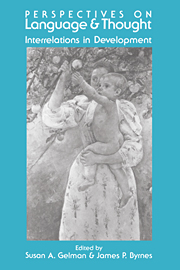Book contents
- Frontmatter
- Contents
- Preface
- List of contributors
- I INTRODUCTION
- II RELATIONS BETWEEN WORD LEARNING AND CATEGORIZATION
- III LOGICAL, CAUSAL, AND TEMPORAL EXPRESSIONS
- 7 Language and the career of similarity
- 8 The matter of time: Interdependencies between language and thought in development
- 9 Constraints on the acquisition of English modals
- 10 Acquisition and development of if and because: Conceptual and linguistic aspects
- IV THE ROLE OF SOCIAL INTERACTION
- Author index
- Subject index
10 - Acquisition and development of if and because: Conceptual and linguistic aspects
Published online by Cambridge University Press: 05 January 2012
- Frontmatter
- Contents
- Preface
- List of contributors
- I INTRODUCTION
- II RELATIONS BETWEEN WORD LEARNING AND CATEGORIZATION
- III LOGICAL, CAUSAL, AND TEMPORAL EXPRESSIONS
- 7 Language and the career of similarity
- 8 The matter of time: Interdependencies between language and thought in development
- 9 Constraints on the acquisition of English modals
- 10 Acquisition and development of if and because: Conceptual and linguistic aspects
- IV THE ROLE OF SOCIAL INTERACTION
- Author index
- Subject index
Summary
Introduction
It has long been held in psychological and philosophical circles that important insights into the nature of cognitive processes can be gained through an analysis of the connectives if and because (Traugott, ter Meulen, Reilly, & Ferguson, 1986). In particular, if … then statements serve the important linguistic function of expressing fundamental cognitive processes such as inference and prediction, and because statements figure prominently in the cognitive processes of argumentation and explanation. Moreover, while the structure and function of these connectives make them particularly useful for describing causal relations, they are also ideally suited for characterizing a variety of other relations among objects or events.
Linguistically, these connectives are important to study because if and because constructions fall within the category of “complex” sentences (as opposed to “simple” or “compound” sentences). Specifically, such constructions often consist of the embedding of one sentence into another. For example, in “If today is Tuesday, the bill is overdue,” each of “Today is Tuesday” and “the bill is overdue” could stand alone. Developmental psycholinguists have found it important to study how children progress from the connectiveless juxtaposition of sentences to the integration of sentences within a single connective construction (e.g., Hood & Bloom, 1979). In addition, an adequate semantic analysis of if constructions has proved to be quite a complex and vexing issue and one that has generated a great deal of interest (Fillenbaum, 1986). The elusiveness of the meaning of if for adults makes one wonder how children ever come to acquire if constructions.
Information
- Type
- Chapter
- Information
- Perspectives on Language and ThoughtInterrelations in Development, pp. 354 - 394Publisher: Cambridge University PressPrint publication year: 1991
Accessibility standard: Unknown
Why this information is here
This section outlines the accessibility features of this content - including support for screen readers, full keyboard navigation and high-contrast display options. This may not be relevant for you.Accessibility Information
- 3
- Cited by
